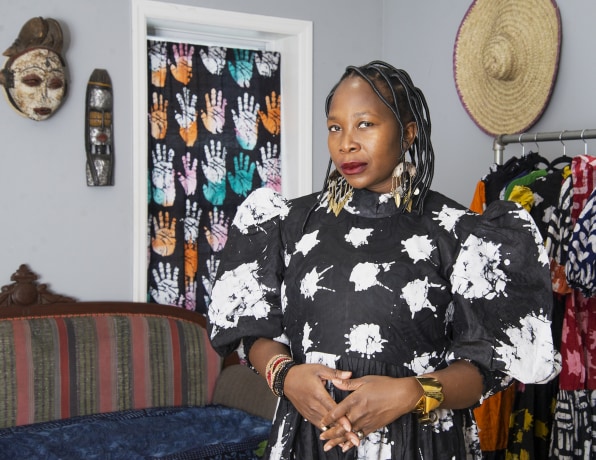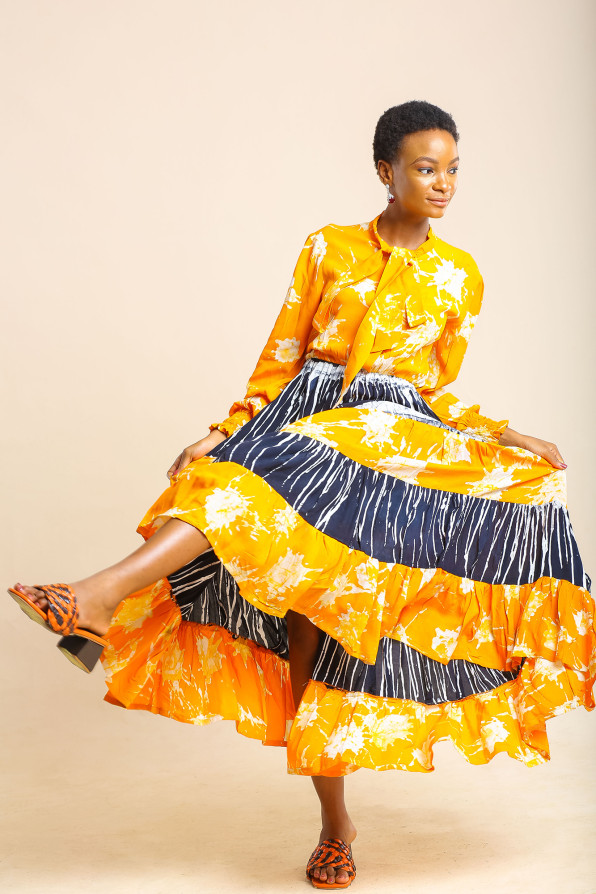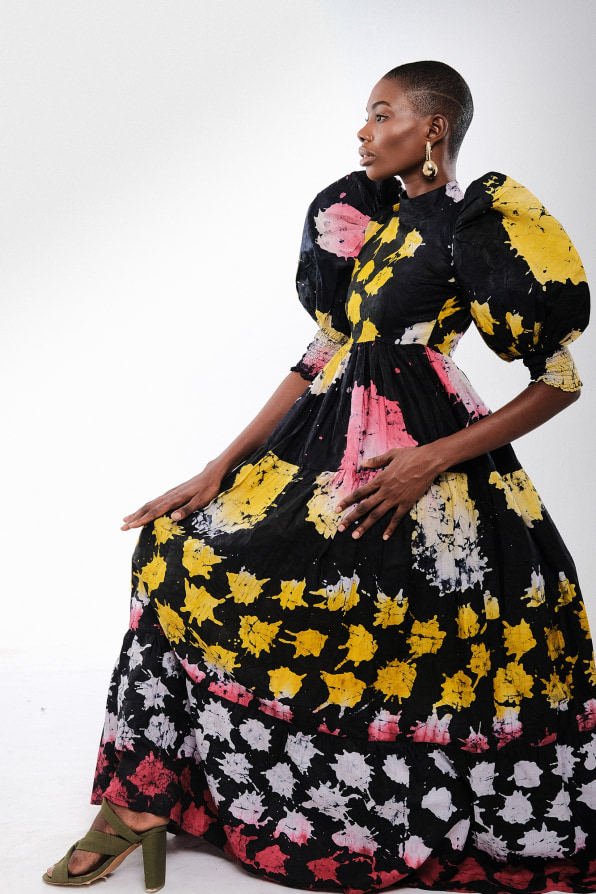Busayo Olupona didn’t always love the vibrant clothes of her native Nigeria. When she moved from Lagos to California, she showed up for her first day of middle school in a colorful, patterned Nigerian dress only to be ridiculed mercilessly by her white classmates.
Today, Olupona is the designer behind the eponymous label Busayo, a fast-growing brand for women and men that centers on these same Nigerian prints, introducing Americans to the beauty of African textiles and craftsmanship. And far from being mocked, her collections appear on the pages of Vogue, the shelves of Saks Fifth Avenue, and on the red carpet, worn by the likes of Madonna, Lupita Nyong’o, and Leslie Odom Jr.
Olupona launched her label in 2011, and its success in the decade since reveals a lot about how American culture has become more diverse and inclusive since she was a child. But over the last two years, as the U.S. experienced a profound racial reckoning, Busayo has really hit its stride, growing in relevance and popularity, as consumers have been eager to explore and celebrate African design through fashion.

An immigrant story
Olupona was born in the U.S. to parents who were graduate students; they returned with her to Nigeria when she was 3. She spent her childhood surrounded by uncles, aunts, and cousins, eating traditional stews and rice, and wearing clothes made from traditional textiles in elaborate patterns and bold colors. Olupona’s father got a job at the University of California, Davis, when she was 11, so the family moved back to the States.
In middle school, she began to see the chasm between how American kids imagined Africa and the actual place she knew and loved. “At the time, the zeitgeist about Africa revolved around poverty, particularly the famine in Ethiopia,” she recalls. “Kids asked me horrible questions like, ‘Do you people even wear clothes?’ I stopped wearing Nigerian clothes, but my identity as an immigrant—which meant that I was outside mainstream culture—was cemented early on.”
As Olupona attended college and then law school in the U.S., her relationship with her Nigerian heritage became more complicated. She traveled back to visit relatives several times a year and loved feeling connected to the food, music, and aesthetic of her home country. But she also felt rooted in her life in America, where she was building a career and had a large network of friends. Over time, she found that fashion was a way to incorporate the various aspects of her identity.
“I really wanted to wear things that I thought were at the intersection of my two cultures,” she says. “Clothes that were really print-heavy and dynamic, reflecting my Nigerian background, but that I could also wear to work in the United States. I was intrigued by this middle ground; I see myself as having my feet in both places.”

At first, this manifested in clothes she designed for herself. When she visited Nigeria, she would buy swaths of fabric in the dynamic prints she loved and bring them to a local seamstress. Rather than turning them into traditional Nigerian costumes, she wanted to create simpler silhouettes that were more common in the U.S., like button-down shirts, sleeveless dresses, and A-line skirts. Olupona was inspired by Diane von Furstenberg’s work in the early 2000s, which featured loud, colorful patterns in streamlined silhouettes.
When Olupona graduated from law school, she got a job at a prestigious firm where she was expected to wear formal, professional outfits. She showed up to work in pantsuits, pencil skirts, and blouses—all made with traditional Nigerian fabric. And unlike the classmates who teased her years before, her colleagues loved the outfits. “This was New York, a decade and a half later,” she says. “People would stop me to say, ‘What are you wearing, and where can I get one?’”
In 2011, she discovered that she might be able to turn her passion for clothes into a business. At a small birthday party at her apartment, Olupona and her sister were both wearing fabulous numbers that she’d designed, and guests wanted to know where they could get similar outfits. Olupona had several samples in her closet and sold three dresses that night, making more than $500. And just like that, Busayo was born.

The African diaspora
Since Olupona had no fashion training, she bought a stack of books about how to launch a fashion business. She also made regular trips to Nigeria, where she studied different textiles and even apprenticed for a master textile maker. She decided to focus on Adire, a technique of dying cotton that was developed by her tribe, the Yuroba people. She wanted to work with Nigerian craftspeople to develop new Adire patterns, then work with Nigerian seamstresses to transform them into the silhouettes that she’d designed for herself over the years.
At first, her business grew slowly, through pop-up shops in New York and other major U.S. cities. She realized that she wanted to create pieces that were African-inspired but not exclusively rooted in Yuroba or Nigerian culture. As an African woman in the U.S., she felt a kinship with people from other African nations, and she also felt connected to African Americans, simply because she was so often identified as part of that community. She wanted her clothes to encompass all of these cultures.
“So many of my customers in the early years were Black women who were attracted to the brand because I was telling a diasporic story,” Olupona says. “My brand was about a global Blackness across the diaspora.”
Busayo started by selling directly to consumers, with garments that cost between $135 and $465. But over the years, small boutiques around the country, then department stores like Saks Fifth Avenue, began carrying her collections, which helped give the brand more exposure. As sales of her designs grew, Olupona continued to work with the same team of fabric makers and seamstresses. “They’ve now moved into proper production workshops and work entirely on my brand,” she says.
Many customers related to Olupona’s own journey of returning to Nigeria and learning about her heritage as a Yoruba woman. And for African Americans whose lineage is murkier because their ancestors were enslaved, a brand like Busayo is a way to connect with a broader African identity. “With my brand, I do share what I know about the cultures and traditions of my specific tribe in Nigeria,” she says. “But I hope it feeds the curiosity of people who don’t know exactly where on the continent they come from. I hope it inspires them to perhaps even visit Africa for themselves.”

Busayo has also served as a powerful tool for connecting Black people from different backgrounds. One night in 2017, for instance, Olupona posted a video on Instagram of a model getting her hair wrapped in a style that was popular when she was growing up in Nigeria. The next day, the video was flooded with comments and the account had 2,000 new followers. “Black American women were intrigued by this hairstyle,” she says. “Women in Kenya talked about how they had the same technique but called it something else. It was beautiful and rich, hearing from these women across the world.”
After George Floyd was murdered in Minneapolis and a wave of Black Lives Matter protests broke out around the world, Olupona’s message seemed to resonate even more strongly. Some consumers wanted to assert their Blackness through what they wore in everyday life; Busayo’s Pan-African aesthetic allowed them to send a message about their identity, but look appropriate in office settings and at parties. And consumers of other ethnic backgrounds wanted to show their appreciation of African culture and their support of the Black community. The brand has a number of celebrity fans as well: In 2020, Keke Palmer appeared in a cover shoot for Fault magazine dressed in Busayo, and Madonna took to Instagram in a floor-length, high-collared Busayo dress. This year, Leslie Odom Jr. chose Busayo for a cover shoot for LA Confidential magazine.
Olupona is now eager to ensure that the brand is inclusive enough so that people who aren’t Black still feel like they can wear the pieces. She believes that the careful way she’s blended African prints with Western silhouettes should allow anybody to wear her clothes without feeling like they’re appropriating another culture. “The project, for a long time, was creating this sense of global Blackness,” she says. “But I make clothes for everyone. I like to think of my pieces as a form of wearable art, and I want everybody to feel like they’re entitled to own them.”
from WordPress https://ift.tt/3sZKLdL
via IFTTT

No comments:
Post a Comment